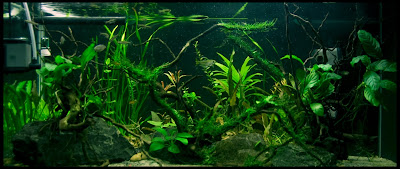The Golden Pencilfish (Nannostomus beckfordi) comes
from the river basins of Guyana, the Rio Negro, and
the lower areas of the Amazon basin.
This fish attains about 2.6 inches (6.5 cm) in total length.
The females are slightly fuller than the slender, more colorful males,
whose pelvic fins have white margins.
This calm and peaceful species, although quite shy, is sociable.
The groups are hierarchical and at certain times
the males defend small territories as N. mortenthaleri do.
Nannostomus beckfordi prefers densely planted aquariums
with dark sand as a substrate, little water movement,
and peat in the filter.
The temperature should be
72–86°F (22–30°C), the pH 6.0–7.5, and the hardness
4–20°dGH.
These omnivores accept almost any food—live, frozen,freeze-dried, or dry.
http://www.seriouslyfish.com/species/nannostomus-beckfordi/





